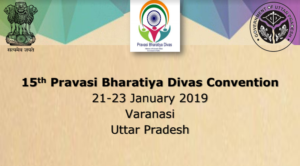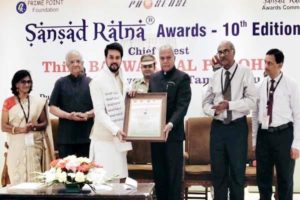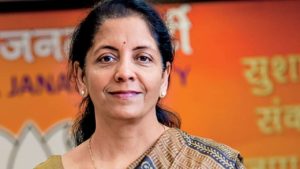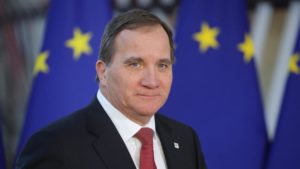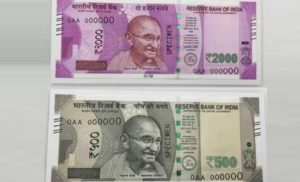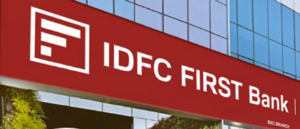VisionIAS
12:18

📰 Centre proposes to hike monthly pensions for the elderly poor, disabled and widows
Plan likely to be part of interim Budget
•Ahead of the 2019 election, the Rural Development Ministry has proposed that the monthly pensions of the elderly poor, disabled and widows be increased from the current ₹200 to ₹800. For those above the age of 80, the proposal is to increase the pension from ₹500 to ₹1,200 a month.
•The Ministry has submitted the proposal, which would have an additional annual cost implication of ₹18,000 crore, to the Finance Ministry to be considered for inclusion in the interim Budget to be presented on February 1.
•“The proposal is being scrutinised for the possibility of inclusion in the Budget speech,” said a senior official of the Rural Development Ministry, which administers the National Social Assistance Programme (NSAP).
•If the proposal is announced, the Ministry will then move the Cabinet to approve the increase in pensions, said the official.
•Separately, a study has been launched to consider doubling the number of people covered by the scheme, a promise originally made in last year’s Budget.
•Discussions are also being held with the State governments on a proposal to merge the Central and State pension schemes. The BJP’s defeat in the recent Assembly elections has forced the Centre to consider sops for rural India.
•The Centre has been considering various welfare measures to benefit rural Indians and farming communities before the Lok Sabha election. Senior government officials have mentioned income support, interest waivers and increased access to credit as some of the other measures being considered.
•The NSAP is a Centrally Sponsored Scheme with an annual budget of ₹9975 crore. It currently covers more than three crore people who are below the poverty line (BPL), including about 80 lakh widows, 10 lakh disabled and 2.2 crore elderly. Those who are older than 80 years are paid ₹500 per month, while the rest are given ₹200 per month. These amounts have not been revised since 2007. State governments add their own contribution, ranging from less than ₹500 to ₹2000 per month.
•“The scheme will need a total budget of ₹30,000 crore in order to increase the pension amounts to ₹800 and ₹1200,” said the Ministry official.
•In his last budget speech in February 2018, Finance Minister Arun Jaitley had said that the government “is implementing a comprehensive social security and protection programme to reach every household of old, widows, orphaned children, divyaang and deprived as per the Socio Economic Caste Census (SECC).”
•If SECC data was used to determine the number of people covered under the scheme instead of the current BPL criteria, coverage would double to about six crore people. Despite that, Mr. Jaitley said allocation for the scheme would be unchanged. Without additional funds, there has been no concrete move towards using SECC data.
•However, prodded by a Public Interest Litigation petition filed in the Supreme Court demanding universal pension coverage and higher pensions, the Rural Development Ministry decided to commission a comprehensive study to evaluate State and Central schemes before proposing a revamp of the system. That study is likely to be completed by the end of June, said the Ministry official.
•“There is a possibility of merging State and Central schemes to increase coverage. The evaluation study will allow us to take an informed decision. But we will have to decide a new cost-sharing ratio [between Centre and States],” said the official, adding that initial discussions with State governments had been held on January 16. Several States, including Rajasthan, Telangana, Bihar and Uttar Pradesh, have already shifted to SECC data for their own pension schemes.
•In its December 13 order on the PIL, the SC had said: “It is high time that the Government of India has a relook at these schemes and perhaps overhaul them with a view to bring about convergence and avoid multiplicity. In particular, the Government of India and the State Governments must revisit the grant of pension to the elderly so that it is more realistic. Of course, this would depend upon the availability of finances and the economic capacity of the Government of India and the State Governments.”
📰 The ambiguity of reservations for the poor
While the constitutional amendment may survive the ‘basic structure’ test, the hardest test will be its implementation
•The 103rd Constitution Amendment Act introducing special measures and reservations for ‘economically weaker sections’ (EWS) has been perceived as being obviously unconstitutional. This article is sceptical of such a reading and takes the view that a constitutional challenge to the amendment will take us into unclear constitutional territories. The strongest constitutional challenge might not be to the amendment itself but to the manner in which governments implement it. There is no foregone conclusion to a potential challenge and we would do well to start identifying the core constitutional questions that arise. To be clear, I am here concerned only with questions that arise within constitutional law.
Special measures
•Article 15 stands amended enabling the state to take special measures (not limited to reservations) in favour of EWS generally with an explicit sub-article on admissions to educational institutions with maximum 10% reservations. The amendment to Article 16 allows 10% reservations (and not special measures) for EWS in public employment and does so in a manner that is different from reservations for Scheduled Caste/Scheduled Tribes and Other Backward Classes. The amendment leaves the definition of ‘economically weaker sections’ to be determined by the state on the basis of ‘family income’ and other economic indicators. Also critical to this amendment is the exclusion of SC/STs, OBCs and other beneficiary groups under Articles 15(4), 15(5) and 16(4) as beneficiaries of the 10% EWS reservation.
•A good point to start the consitutional examination is the Supreme Court’s view on reservations based purely on economic criteria. Eight of the nine judges in Indra Sawhney (November 1992) held that the Narasimha Rao government’s executive order (and not a constitutional amendment) providing for 10% reservations based purely on economic criteria was unconstitutional. Their reasons included the position that income/property holdings cannot be the basis for exclusion from government jobs, and that the Constitution was primarily concerned with addressing social backwardness.
Basic structure doctrine
•However, the decision in Indra Sawhney involved testing an executive order against existing constitutional provisions. In the current situation, we are concerned with a constitutional amendment brought into force using the constituent power of Parliament. The fact that we are not concerned with legislative or executive power means that the amendment will be tested against the ‘basic structure’ and not the constitutional provisions existing before the amendment. The pointed question is whether measures based purely on economic criteria violate the ‘basic structure’ of the Constitution? I do not think it is a sufficient answer to say that ‘backwardness’ in the Constitution can only mean ‘social and educational backwardness’. Citing the Constituent Assembly debates is not going to take the discussion much further either. It is difficult to see an argument that measures purely on economic criteria are per se violative of the ‘basic structure’. We can have our views on whether such EWS reservations will alleviate poverty (and they most certainly will not), but that is not really the nature of ‘basic structure’ enquiry. Providing a justification for these measures as furthering the spirit of substantive equality within the Indian Constitution is not very difficult.
•Economic criteria (if seen as poverty) forms the basis for differential treatment by the state in many ways and it would be a stretch to suddenly see it as constitutionally suspect when it comes to ‘special measures’ and reservations in education and public employment. Poverty inflicts serious disadvantages and the prerogative of the state to use special measures/ reservations as one of the means to address it (however misplaced it might be as a policy) is unlikely to fall foul of the ‘basic structure’ doctrine.
•A challenge to the amendment may lie in the context of Article 16 by virtue of shifting the manner in which reservations can be provided in public employment. Under Article 16(4), reservations for backward classes (SC/STs, OBCs) are dependent on beneficiary groups not being ‘adequately represented’ but that has been omitted in the newly inserted Article 16(6) for EWS. The amendment through Article 16(6) ends up making it easier for the state to provide reservations in public employment for EWS than the requirements to provide reservations for ‘backward classes’ under Article 16(4). In a sense that is potentially a normative minefield for the Supreme Court. On the one hand, it is confronted with the reality that ‘backward classes’ like SC/STs and OBCs are disadvantaged along multiple axes and on the other, it is now far more difficult for the state to provide reservations to these groups compared to the EWS. The response might well be that ‘representation’ is not the aim of EWS reservation and questions of ‘adequacy’ are relevant only in the context of representation claims like those of the backward classes under Article 16(4).
Questions and challenges
•In many of the responses to the amendment, breaching the 50% ceiling on reservations has been cited as its greatest weakness. It is hard to see the merit of that argument because the amendment by itself does not push the reservations beyond 50%. While it might be a ground to challenge the subsequent legislative/executive actions, the amendment itself is secure from this challenge. But even beyond this narrow technical response, the 50% ceiling argument is far from clear. In Indra Sawhney, the majority of judges held that the 50% ceiling must be the general rule and a higher proportion may be possible in ‘extraordinary situations’. Fundamentally this argument stems from an unresolved normative tension in Indra Sawhney. While committing to the constitutional position that reservations are not an ‘exception’ but a ‘facet’ of equality, the majority in Indra Sawhney also invokes the idea of balancing the equality of opportunity of backward classes ‘against’ the right to equality of everyone else. When governments implement the EWS reservations and push quotas beyond 50%, the Supreme Court will be forced to confront this normative tension. If reservations further equality, what then are the justifications to limit it to 50% when the identified beneficiaries constitute significantly more than 50%? The answer to that question might lie in Indra Sawhney’s position that the constitutional imagination is not one of ‘proportional representation’ but one of ‘adequate representation’. However, as discussed above, if abandoning the ‘adequacy’ requirement per se is upheld for EWS reservations, the basis for a 50% ceiling becomes unclear.
•While the constitutional amendment by itself might survive the ‘basic structure’ test, the hardest test for governments will be the manner in which they give effect to the amendment. The definition of ‘economically weaker sections’ will be a major hurdle because the political temptation will be to go as broad as possible and include large sections of citizens. But broader the definition, greater will be the constitutional risk. For example, if beneficiaries are defined as all those with family income of less than ₹8 lakh per annum, it must necessarily fail constitutional scrutiny. To justify that an individual ‘below poverty line’ and another with a family income of ₹8 lakh per annum belong to the same group for purposes of affirmative action will involve constitutional jugglery at an unprecedented level. But then, the history of our constitutional jurisprudence has prepared us well for such surprises.



